
How real are Red Bull's concerns that Verstappen could leave early?
Helmut Marko caused a stir after the Bahrain GP with his worries that Max Verstappen could leave Red Bull early. But how real are those fears?
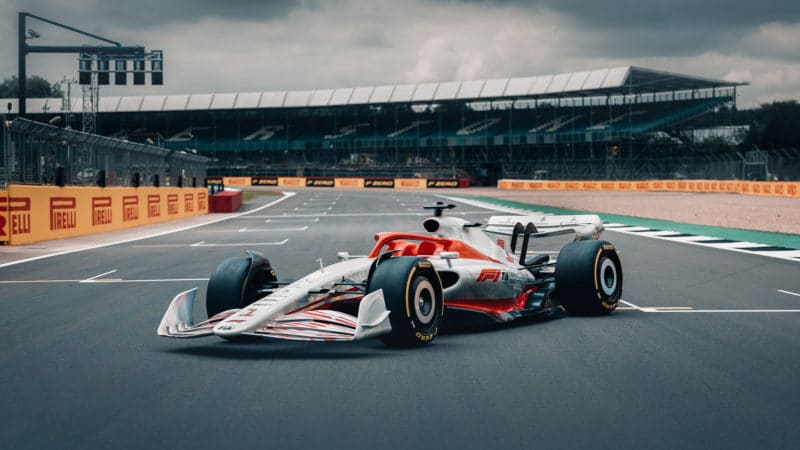
The first full-size Formula 1 car built to 2022 regulations has been revealed by F1, offering a vision of what next season’s grid will look like.
The model represents the most radical overhaul the sport has ever seen, with new technical regulations that fundamentally change the way the cars generate downforce and how the flow of air over their bodywork is managed, in the hope of improving the racing.
Whether these alterations, coupled with cost caps, spec parts and other changes, will truly equalise the field remains to be seen, but what is certain is that F1’s commercial rights owners, Liberty Media and the governing body, the FIA, cannot be accused of not doing their homework, for which they should be commended.
The new regulations were intended to come into force at the start of this season, but were delayed for a year by the Covid pandemic, with aerodynamic work on the new cars frozen until the beginning of this year.
Now, teams are working flat-out to develop their interpretation of the new rules. The key is to make sure someone can’t find a way to break the regulations and get a huge advantage.
Starting in 2017, a high-calibre, in-house team – including Pat Symonds, formerly of Benetton, Renault and Williams, Nicholas Tombazis, formerly of Ferrari – was assembled to make sure the new regulations are not just a stab in the dark, and the teams enlisted to make use of their engineering firepower.
Of course, teams being teams, they all have their own agenda in such matters, but the way the rule-making process has been managed, to a great extent, should have negated this.
The initial concept for the car shown here was Formula 1’s own work. It is the fruition of an extensive aerodynamic research program, the first step of which was simply to understand why it is so hard for one car to follow another. This is a very important point, as without knowing the reason behind the problem, it would be impossible to construct a ruleset to fix it.
To do this, Liberty went out and bought its own F1 car, in the form of the 2017 wind tunnel model and CAD data from the Manor Formula 1 team, following that team’s demise.
This model gave Liberty’s team the perfect basis to run its own CFD [computational fluid dynamics] simulations of the wake generated by a car. It compared the results of these simulations with those gathered in a wind tunnel (Sauber’s) to make sure its results were as true to life as possible. One example of the CFD wake simulations is illustrated.
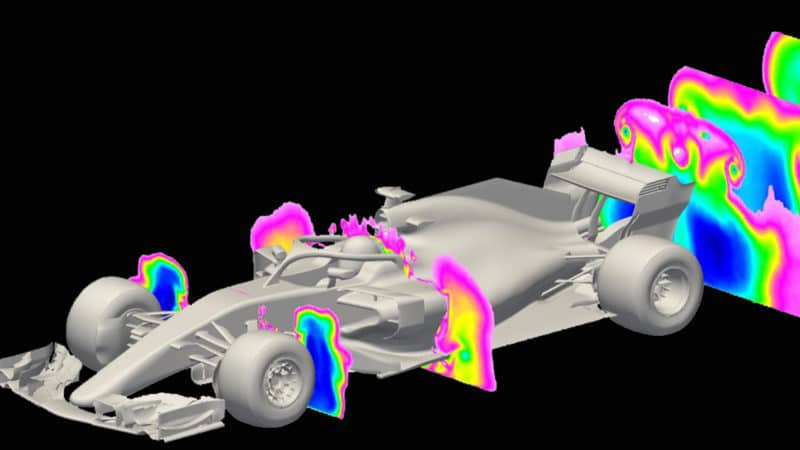
Aerodynamic wake from a 2018 F1 car
F1
Once the group was happy with the validity of the wake model, it was then able to study how the wake interacted with a car following behind, working out how much downforce the following car would lose in various positions and, importantly, why that downforce was being lost. As this process was underway, work also began on an aerodynamic design concept to minimise these effects.
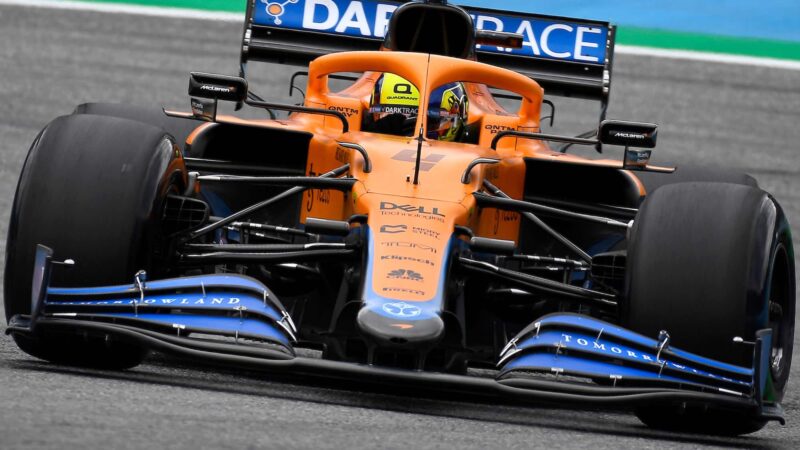
Qualifying and finishing in the top 10 will bring in the bonus points for Lando
Grand Prix Photo
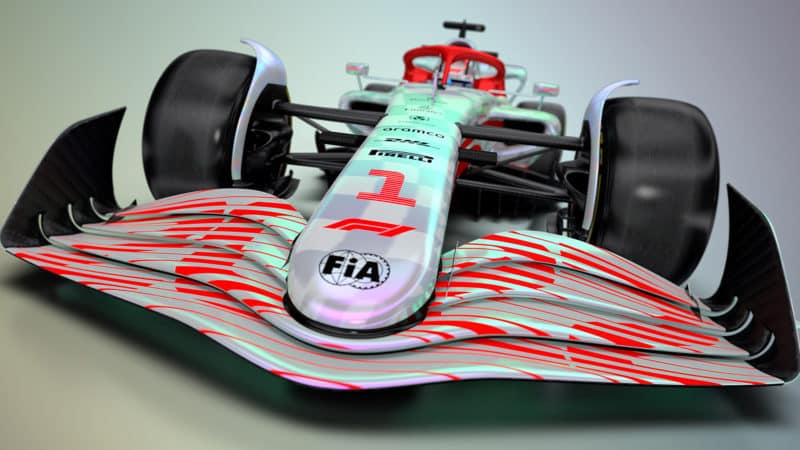
2022-spec front wing
One of the major issues, which was already known but better understood as a result of the research, was the disruption to a following car’s aero performance caused by the air forced out to the side of the car in front.
A modern F1 car is phenomenally complicated from an aerodynamic perspective, but the bulk of downforce is generated by a few key mechanisms: the front and rear wings, the front edge of the floor and the diffuser. In essence, aerodynamicists are trying to manage the airflow over the cars in such a way that air reaches these parts in as controlled a manner as possible.
One of the biggest challenges for an F1 aerodynamicist is managing the messy flow that comes off the cars’ open wheels, both from the top of the wheel and its underside where it meets the track. The aim being to stop this ‘wake’ from the wheels disrupting the carefully constructed flows around the centre of the car.
You may have heard the term Y250 vortex bandied around in this context. All this is (in very simple terms) is the airflow running down the centre of the car, which is greatly influenced by the vortices that spin off the stacked wing elements, which end abruptly at the point they meet the spec central section of the front wing, extending 250mm either side of the car’s centreline (hence the Y250 vortex, Y being the axis down the centre of the car).
All of the protrusions, winglets and other carbon flicks that festoon the nose and area along the front sides of a car are designed to fine-tune this flow, maximising its usefulness when it gets to the powerful front floor section and retain its energy as it heads towards the back of the car. Having the wakes from the wheels barging in on this flow would ruin all of this work, hence why teams do everything they can to push these far out to the sides of the car.
The problem being, this makes life difficult for a following car as it ploughs through this mass of jumbled air swirling around at track level.
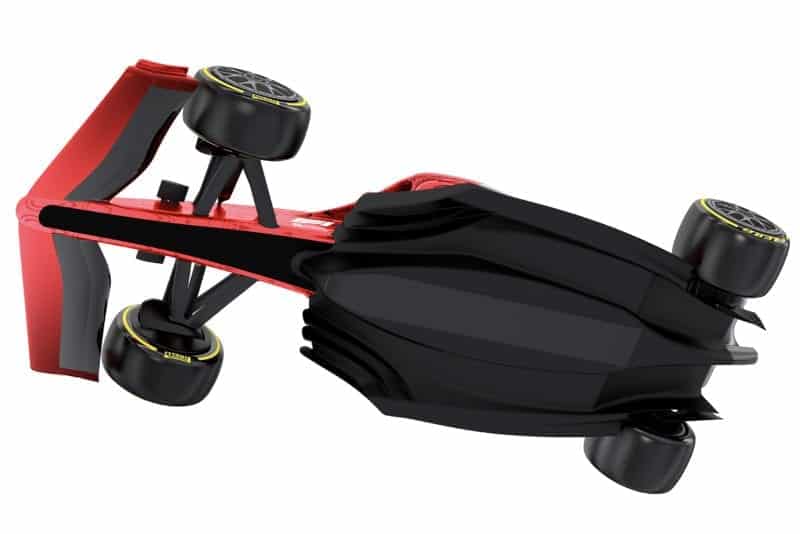
Underneath the 2022 concept car
Liberty’s concept, the first iteration of which was codenamed Hotel, looked to stop the wheel wakes being pushed outboard and at the same time, reduce the detrimental impact of running in ‘dirty’ air.
Instead of placing emphasis on the previously mentioned tools for creating downforce, greater use would be made of the underfloor, with the current flat floor-diffuser set-up replaced with a tunnel system, creating a ground effect set-up where the underside of the car becomes one big venturi.
Generally speaking, and as shown by IndyCar, such an approach is less prone to being upset by the effects of following another car. Of even greater importance is the work Liberty has done to lock down the way airflow off the front wheels is managed.
Looking at the front of a 2019 car, much of the ‘furniture’ towards the outside end of the wing, as well as the brake duct design, is responsible for pushing the wakes outboard, even after changes to the rules for this year reduced freedom in this area (which stemmed from the early 2022 work). The 2022 regulations remove devices used to push the air outboard and the wheel wake is instead sucked back inboard.
With the current cars, this approach would greatly reduce downforce, but with a shift of emphasis to underfloor aero, the impact will be lessened. It also means that the wheel wakes will be drawn along the car, then ejected high up behind the car in the ‘mushroom’ of airflow created by the underfloor and rear wing, pushing it above any following car. The new car design also features a reworked rear aero layout to push this mushroom higher than it currently reaches.
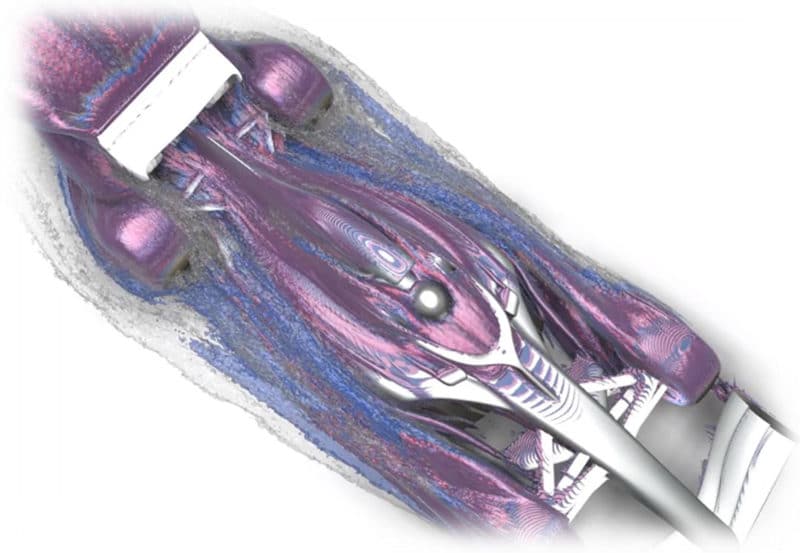
The airflow paths on a 2022 concept car
Overall, the FIA estimates there will be a reduction in overall downforce to levels similar to those seen in 2016, with a consequent reduction in lap times of between 3-3.5 seconds. Teams will use every tool at their disposal to claw back this deficit.
The process by which Liberty refined this concept is also laudable. Once the initial Hotel model was completed, Liberty and the FIA enlisted the assistance of the teams to run detailed CFD studies on the model as both a leading and a following car. The teams were given permission to complete CFD work outside of the current restrictions that the rules enforce, provided strict guidelines were adhered to.
The data the teams gathered was then fed back to Liberty’s team to help refine its model and to allow back-to-back comparison between the wake effects of a 2018 car and the Hotel model. Following this round of work, completed in early 2019, a new model codenamed India, incorporating some modifications, was devised.
The results were certainly encouraging, with a significant reduction in downforce loss for a following car, compared to the current specification.
There then followed two further development periods where the teams looked at specific areas of the model at the bequest of Liberty and the FIA, which concluded at the end of May. The teams also provided input on practical elements of the new design. It is all well and good having a shiny CFD model, but it is not much use if it doesn’t provide sufficient cooling provision, for example.
Detail work on the rules package, and importantly, how teams would be prevented from circumventing them, then continued throughout the summer. This undoubtedly involved much horse trading between those teams that didn’t want their inherent development (read resource) advantage reduced, and those that were quite happy to accept limitations in certain areas. Here, the technical regulations work hand in hand with the sporting regs, which will see new, tighter limits on wind tunnel and CFD testing, restrictions on dyno time for power unit manufacturers and of course, an overall budget cap.
Despite this bartering process, Liberty and the FIA’s concept survived surprisingly intact relative to the designs tested earlier in the year. The most significant changes were to the front wing area, which received a swept-back profile and far sleeker end plates, in an effort to make the cars appear more dynamic.
The rules will prevent teams from undoing all of the regulator’s hard work via a three-pronged approach to limit any developments that try and force air outboard. Firstly, the regulation bounding boxes, and specific regulations relating to the geometry of certain parts (radiuses of surfaces, the directions they can guide air etc) are far tighter than with the current rules. Theoretically, this will prevent teams using parts they are permitted to develop to do things outside of the intent of the regulations.
The second prong will be much tighter policing of cars’ legality. That is not to say that cars today have illegal bodywork, but the form of some areas of the body are not closely defined. The FIA will be assessing a far greater selection of data to ensure a car passes muster, for example, greater use will be made of laser scanning during the scrutineering process in order to check the compliance of surfaces.
Additionally, many of the grey areas regarding what is and isn’t an aerodynamic device have been removed from the rules. In the past, elements such as brake ducts, suspension arms etc did not fall under the aerodynamics section of the rules and thus their actual use was open to interpretation. Now, every part that can have an aerodynamic influence (within reason) is contained within Article 3 of the rules, governing aerodynamic devices.
Finally, any scope for development has been removed in the areas that have the greatest effect on wheel wake control. Nicholas Tombazis stating during the rules launch event, “there are some areas that are so sensitive for the wheel wakes that we felt if we didn’t restrict their shapes, we would end up with teams finding ways to overcome the key objectives [of the rules].”
Specifically, the brake/wheel drum, the outer wheel fairing and the vestigial wheel arch are all now classed as PDC (prescribed design components) which means teams are permitted to produce them in house, but they must be made to a fixed, FIA specified, design. There are a host of other points of technical interest within the (new) classification system for parts, but they warrant a separate article to explain fully.
Labels refer to 2021 rules, since deferred to 2022
The final results from the FIA, Formula 1 and the teams’ myriad of simulations are certainly encouraging. The graph above, produced by F1, shows the gain achieved in following car performance, with the headline figure a loss of just 14% of downforce (green line) when following another car by a length, compared to a loss of 45% for the current car designs.
This comes at the cost of some design freedom for engineers, but arguably, if the measures put in place to control the wilder excesses of teams’ aerodynamicists work, it is for the greater good of the sport. It should also be noted that there remains scope for some fluidity in the regulations, either leading up to 2022 or in subsequent seasons. As Pat Symonds observed, “today is not the end of the process, it is a waypoint.”

Helmut Marko caused a stir after the Bahrain GP with his worries that Max Verstappen could leave Red Bull early. But how real are those fears?

Ayrton Senna’s tragic final races in 1994, marked by controversy over illegal traction control and his relentless pursuit of excellence in a challenging car, remain a poignant chapter in F1 history, as Matt Bishop recalls

Full F1 schedule for the year, including the next F1 race of 2025: the Saudi Arabian Grand Prix, the whole calendar and circuit guides for the 24-race Formula 1 season

Round five of the 2025 Formula 1 season wraps up the first triple-header of the year in Saudi Arabia. There are the dates and start time for the Jeddah event, including all sessions